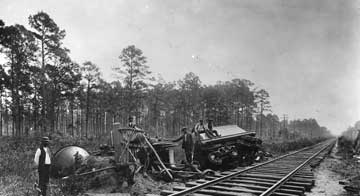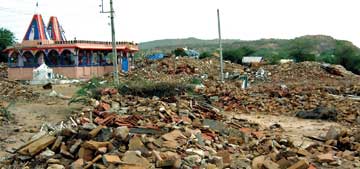|
GEOMEDIA
Check out the latest On the Web links, your connection to earth science friendly Web sites. The popular Geomedia feature is now available by topic.
Sizing up Earthquake Damage: Differing Points of View
Susan Hough with Anne Bolen
 USGS, J.K. Hillers |
| The earthquake that rattled Charleston, S.C., on Aug. 31, 1886, became legendary, killing 60 and causing what was then an estimated $5 million to $6 million in damage, taking down dozens of buildings and derailing locomotives, like this one on Ten Mile Hill. |
When a catastrophic event strikes an urban area, many different professionals hit the ground running. Emergency responders respond, reporters report, and scientists and engineers collect and analyze data. Journalists and scientists may share interest in these events, but they have very different missions. To a journalist, earthquake damage is news. To a scientist or engineer, earthquake damage represents a valuable source of data that can help us understand how strongly the ground shook as well as how particular structures responded to the shaking.
Media reports and private accounts can provide important information about an earthquake’s impact. But a recent study co-authored by Prabhas Pande, director of the Earthquake Geology Division of the Geological Survey of India, and Susan Hough, published in the April issue of the Bulletin of the Seismological Society of America, illustrates how scientists can potentially be led astray by failing to recognize that written accounts tend to emphasize especially dramatic events rather than representative, overall effects.
For a journalist, the news is what happened. When mid-rise buildings collapsed in Mexico City in 1985, that was big news. When the Nimitz Freeway collapsed in Oakland in 1989, that was big news. In any earthquake, the most dramatic damage is the biggest story. If nothing, or not much, happens, that isn’t news. Modest earthquake effects will merit a much smaller story, if one at all. Those who experience an earthquake use the same sort of selection process in relaying what happened, either orally or in correspondence. When people experience something dramatic, they are apt to write letters — or, these days, e-mail messages. As a rule, people don’t tend to write to say, “We didn’t feel the earthquake that happened last Tuesday.”
For the scientist or engineer, however, the damage that didn’t happen can be every bit as important as the damage that did happen. An engineer knows, for example, that isolated damage might not reflect how hard the ground was shaking because in any area, buildings that are relatively poorly built are especially susceptible to damage.
The issue of bias in media reports looms especially large for those earthquakes historically important for their impact on society or their physical devastation or both, such as the one that took place in Charleston, S.C., in 1886. As no modern instruments were available to estimate earthquake magnitudes before the late 19th century, scientists measure this by quantifying the distribution of damage and other effects, such as the area over which the shaking was felt, and then comparing the results to the effects of modern earthquakes for which a magnitude can be determined.
However, the older the earthquake, the more sparse the written record. After the Charleston earthquake struck, Clarence Dutton — an Army captain working for the U.S. Geological Survey — set out to systematically compile every available account. Thanks largely to his efforts, we have accounts of this earthquake from almost a thousand locations. No similar compilation was made after the so-called New Madrid sequence of large earthquakes struck the mid-continent during the winter of 1811 to 1812. For these earthquakes, seismologists have turned to extensive archival searches to unearth written records squirreled away in old newspapers, diaries and letters. This sleuthing has turned up accounts from only about a hundred locations for each of the three largest New Madrid earthquakes.
Written accounts of an earthquake’s effects are obviously quite different from a modern seismogram, but both types of observations represent data. To analyze written accounts of earthquake effects, the seismologist first assigns an intensity value based on the severity of documented effects. Intensity values differ from magnitude values in that the latter reflect the size of the earthquake itself, whereas intensity reflects the severity of shaking at a particular location. Confusions sometimes arise because intensity and magnitude values span a similar range. In fact, the magnitude scale is open-ended, and tiny earthquakes can have negative magnitudes. Intensity values, usually denoted by Roman numerals, are defined to span a range of I to X. Intensity I corresponds to shaking that is not felt while intensity X corresponds to shaking that is strong enough to cause significant damage to even well-built modern structures.
As intensity values are assigned to old, often brief, archival accounts, one question often rattles in the back of seismologists’ minds: Do available accounts provide a good overview of an earthquake’s effects? The nagging voice suspects the answer is no. But how does one evaluate information that isn’t there? If the only available account of an earthquake just describes damage done to adobe houses in a certain town, it is hard to know if they were the especially poorly built structures in that area or not.
Sometimes more recent newspaper articles are helpful in this regard, for example, noting that adobe buildings collapsed while wood-frame houses were only lightly damaged. But often older newspapers are less helpful and the seismologist is left guessing.
 Copyright Roger Bilham |
| The earthquake that struck Bhuj, India, on Jan. 26, 2001, killed 18,500 people and destroyed all dwellings in some villages, but left some well-built temples intact. Although earthquake-resistant building codes existed, they were not evenly applied. |
The 2001 Bhuj, India, earthquake provided a unique opportunity to quantify the media bias. This magnitude-7.6 earthquake struck western India on Jan. 26, 2001, claiming nearly 20,000 lives and causing extensive damage throughout the state of Gujarat. Immediately after the earthquake, seismologists realized that damage surveys would be invaluable because the earthquake was only recorded on a handful of instruments within India, none of them very close to Bhuj.
An early study analyzed media accounts of the earthquake published on the Web and in local newspapers to assign intensity values for more than 200 locations in India and Pakistan. In the meantime, the Geological Survey of India sent out teams to survey the damage directly. These teams were charged specifically with assessing the overall severity of earthquake effects in towns throughout India. When their map was complete, it could be compared in detail with the media’s map. The comparison revealed that the two approaches yielded similar results for low intensities. When media accounts report that an earthquake was lightly felt in a certain town, it appears that such accounts tend to be representative. But in regions where damage occurred, the suspicious nagging voice proves to be correct: Intensity values based on media accounts were systemically biased toward higher values than those based on direct surveys.
The availability of two independent intensity surveys for the Bhuj earthquake allowed media bias to be analyzed in some detail — but only for this particular earthquake. It is not clear that reporting in modern newspapers and Web sites is comparable to that in newspapers and private letters from 100 or 200 years ago. However, the results of the Bhuj comparison provide at least a preliminary quantification of how older archival accounts might be biased. On an encouraging note, the results suggest that archival accounts of historical earthquakes can provide a good indication of the area over which shaking was felt. Comparing the extent that historical and modern earthquakes were felt therefore may yield more reliable results than comparing the extent of damage.
This study also serves as a reminder that the news media past and present can help seismologists do their job, but it remains part of the seismologist’s job to understand the nature — and the limitations — of the information that journalists provide.

 Subscribe
Subscribe


